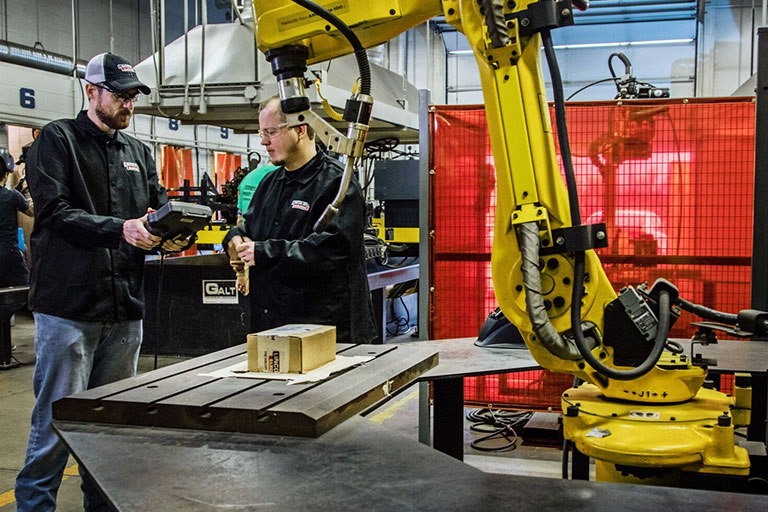Prepare for the dynamic future of manufacturing. Gain job-ready skills in cutting-edge computerized manufacturing methods and computer-aided drafting techniques.
What is Computerized Manufacturing and Machining?
Work activities in machine shop involve applying knowledge of machine capabilities, the properties of materials, and shop practices to set-up and operate various machines. The skills needed to position work pieces, adjust machines, and verify the accuracy of machine functions and finish products are taught by classroom instruction, demonstration, and hands on experience.
Students enrolled in the Machine Tool Technology program must achieve a minimum grade of C in each BRX, MTT, and IE Core. See program checklists for more information.

- Machinist
- Layout Worker
- Computer Controlled Tool Operator
- Structural Metal Fabricator
- Structural Metal Fitter
- CNC Machinist
- CNC Operator
- Tool and Die Apprentice
CMM Employment Qualifications
Skilled machinists are always in demand and will be as long as there is a machine to provide a product to assist in agriculture, to construct homes and buildings, to save time and energy, to produce energy, and to provide recreation. The machinist is the person who builds and maintains these products (machines). Students completing the Computerized Manufacturing & Machining program may find employment as machinists, machine operators, or in machine maintenance repair in numerous industrial plants in the area.
As a one-year Computerized Manufacturing & Machining student, you should be able to:
- Think mechanically
- Perform complex mathematical calculations
- Work well under pressure
- Enjoy working with your hands
- Work at repetitive tasks
- Give attention to detail
- Assume responsibility
- Organize your work
- Work with a variety of skilled and non-skilled workers and professionals
- Take constructive criticism
- Work well under supervision
Employers will expect you, as a two-year Computerized Manufacturing & Machining graduate, to be able to:
- Operate machine tools safely.
- Acquire skills in the use of hand-held tools.
- Apply knowledge to the operation of the lathe, milling machine, surface grinder, and drill press.
- Use physical and mechanical properties of metals and alloys in tool production.
- Analyze and set up machining operations according to prints, layouts, and other instructions.
- Categorize and select the correct cutting and lubrication fluids used in machining operations.
- Compare measured tolerance limits with micrometers, gauges, and other precision instruments.
- Set up and operate computerized numerical control (CNC) milling machines and lathes.
- Create part drawings and generate tool paths using a computer-aided drafting and computer-aided machining (CAD/CAM) system.
After graduating from the two-year Computerized Manufacturing & Machining program, you will be ready to start your career as a:
- Machine Operator
- Machinist Apprentice
- Machine Setup Operator
With further training, graduates may advance to All-Round Machinist, Tool and Die Maker, Mold Maker, Machine Programming, Machine Shop Operator, or Tool-Machine Setup Operator.
Getting Started
What are my degree, diploma, and certificate options?
The catalog describes the course requirements for completing the credential. Students are required to schedule an appointment with their assigned academic advisor to ensure achievement of their academic goals.
How Do I Pay For This?
What Else Do I Need to Know?
Specialized Training Opportunities
Computerized Manufacturing & Machining is committed to providing training on state-of-the-art equipment that is located at our two lab locations. We provide all specialized training through our Workforce Solutions department.
High Bay Dress Code
Because of safety and other concerns in the High Bay Area of BCTC’s Advanced Manufacturing Center in Georgetown, a dress code has been established and will be enforced. This dress code has been established with the approval of the college's administration.
Information about the dress code can be found on the Advanced Manufacturing Program (AMT) page.
Additional Information
We have chosen to stress the learning of functional tasks rather than to promote an environment where students choose their own projects. All of our laboratory exercises are designed to introduce students to a broad scope of tasks typically performed on conventional or CNC machines. Our technical advisory group annually reviews our curriculum. They guide our decisions to include new topics, delete out-of-date ones, and to continue those that are still viable.
Our conventional machining program stresses the set up and operation of lathes and vertical mills for a wide variety of processes. The classes provide instruction in blueprint reading, shop math, measurement and inspection, job planning, safety, and general machining theory. Our CNC program also emphasizes the set up, operation, and programming of vertical mills and lathes; to include aspects of wire and sinker EDM.
In manual programming courses students learn proper formatting of CNC code, calculations related to determining coordinate data, proper use of programming techniques such as the use of sub programming, and experience cutting parts using their own programs on our CNC machines. In computer assisted programming classes student learn how to use software such as Esprit to generate machine code for CNC mills and lathes. All classes are structured with time allocated for lecture/demonstrations and hands-on laboratory time.
Length of Program
You can earn an associate in applied science degree in two years if you maintain full-time status.
This information should not be considered a substitute for the KCTCS Catalog. You should always choose classes in cooperation with your faculty advisor to ensure that you meet all degree requirements.

